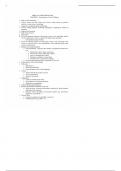ADMS 1010- MIDTERM REVIEW
CHAPTER 1- Introduction to Critical Thinking
1.What is critical thinking?
oCritical: comes from the Greek word, , which means to question, kritikos
analyze, or make sense of something
oApproach to reading, thinking and learning oInvolves asking questions, examining assumptions, weighting the validity of
argum ent Explicit and Conscious
Make better decision 2.Proposition: The most important element of democratic society is the individual and the
role of a democratic society is to protect the rights of the individual
∆Individualism (Adam Smiths) oThe most important element of a democratic society is the well being of the
society as a whole and it is the responsibility of the individual protect that
society (Collectivism) 3.Sharpen Your Analytical Skills
a.Critical thinking – Analyzing the validity of arguments presented in a
text
Identify the author ’s major conclusions
Describe & evaluate supporting evidence
Uncover assumptions & values
Determine soundness of causal logic
Deconstruct use of persuasive language
b.Develop and present persuasive ar guments of your own
4.Characteristics of the critical thinker oSelf-aware:
Introspective
Know personal biases
Name strategies used to make judgments
oCurious:
Explore beneath the surface of issues
Try new approaches
Seek new viewpoints
oIndependent:
Listen to and learn from others
Develop their own informed opinions
Make their own judgments
5.Critical T hinking about Business: oBusiness the dominant institution of our time:
Main discourse: economic performance, productivity , global markets,
and financial investments…
Business values: spreading to non-business spheres (e.g. universities,
health-care, government…)
oCurrent affai rs:
Corporate scandals of early 2000s (e.g. Enron)
Global financial crisis (2008 - ??) oEthics, CSR, governance, sustainability…
oAge of the expert:
Trouble with experts:
oLots of NOISE (uncertainty) in the business world
o“Experts” step in to fill the void:
They’re often wrong
They disagree
oNeed to develop procedures to assess truth or validity of dif ferent
6.Dimension of Critical T hinking oCentral claims oQuality of evidence oUnderlying assumptions and values oCausal claims oTechniques of persuasion CHAPTER 2: MANAGEMENT
1.What is ADMS?
oSchool of Administrative Studies (SAS)
oAdministrative = Management
oAdministrating/Managing what?
Primary focus on business
But also, government, not-for -profits oSAS is ef fectively a business school (B-school) 2.Brief history of b-school: The Early Year: oThe world's first business school, 1819 – ESCP Europe was founded
in Paris, France. It is the oldest business school in the world and now has campuses in Paris, London, Berlin, Madrid, and T orino.
oFirst collegiate business schools established around turn of century (1900s)
Wharton, U. of Pennsylvania, est. 1881
U. of Chicago Graduate School of Business (now the Booth School of
Business), est. 1891
Harvard Business School, est. 1908
oReflected the rise of the modern, publicly-traded corporation
oThe Aim:
oOriginal intent was to develop a professional degree similar to law &
medicine:
oManage corporations in the interest of a variety of stakeholders:
Shareholders
Customers
Employees
Society
oCode of ethics
oStandardized body of knowledge
o“The education students received was neither rigorous nor especially
effecti ve” (Escher , 2010)
oThe Growth Year:
Rapid growth of B-schools following WWII Returning soldiers needed jobs
Public policy goal to have no unemployment
Carnegie & Ford foundations commission studies of business education in
the late 1950s
owhy would they do this?
oissued in shift to a more traditional academic curric ulum, with
specialized, functional disciplines
oled to greater legitimacy and power within universities
Rapid growth of post-secondary business programs continues to the present
oCharacteristic: oMilton Friedman’ s view predominant: Goal of business is to m aximize profit
oPractitioner focus: Purpose is to educate business managers
oTwo main teaching methods:
Traditional skills-based, lecture style
Case-method
oCase-method
Developed at Harvard Business School
oNo business textbooks when HBS founded (1908)
oWhat they did:
Interviewed leading business practitioners
Wrote a detailed account of what they did
oAre these BEST PR ACTICES??
oLack of criteria to judge whether actions were good or bad
So, instead:
Read the case -> discuss in class -> of fer recommendations
oStudent takes on role of decision maker (i.e. the manager)
3.The manager - what managers do?
The manager: The person in char ge of the organization or one of its subunits
Classical view: aka, The rational view
Provided by French industrialist, Henri Fayol in 1916
Managers:
Plan
Organiz e
Coordinate
Control
∆Folklore and Fact:
∆Myth 1: Planning ∆Folklore: T he manager is a reflective, systematic planner
Fact:
Managers work at an unrelenting pace
Activities are characterized by brevity , variety , discontinuity
Managers like action, avoid reflection
∆Evidence:
½ of activities last less than 9 minutes
Average 583 activities in 8 hour shift (1 every 48 seconds)
Work for ½ hour or more once every 2 days
∆Myth 2: Duties Folklore:The effe ctive manager has no regular duties
Fact:




